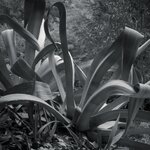This is a bit surprising given your dedication to exploring and documenting your city, Gianluca. I'm seeing tentacles in those agave leaves.
You got it right: tentacles. That's probably the first thing that comes to mind, right? But if you look closely, you can see in it the movement of those leaves slowly growing in the half-light in search of the light they needed, at the same time trying not to collide with each other. Bending, twisting, coiling even, constrained by the double cul-de-sac generated by conflicting needs: the search for sunshine and the necessity to avoid injuring one another. To me it looks like a slow motion ballet of swords, where the fighters instead of seeking confrontation are attempting to avoid any possibility of it, and this ballet took decades to develop. Can you see it? Are you able to perceive the temporal dimension?
I was there hunting for human arts and artefacts (‘documenting the city’, as you say), but I didn't find any in there. These agaves caught my eyes and I'm really sorry I couldn't get the perfect frame as I was constantly interrupted by the stares of the inhabitants passing by.
But in the end I love this photo, it satisfies me aesthetically. And
that is strange because other photos of mine that to me are mundane, taken on the spur of the moment, without any study, when shared in this forum seem to be much appreciated. On the other hand, when I spend time trying to take the photo I have in mind, that photo published here almost doesn't provoke a single comment. That's fine, this is what makes it useful to share a photo and listen to the opinion of others.

